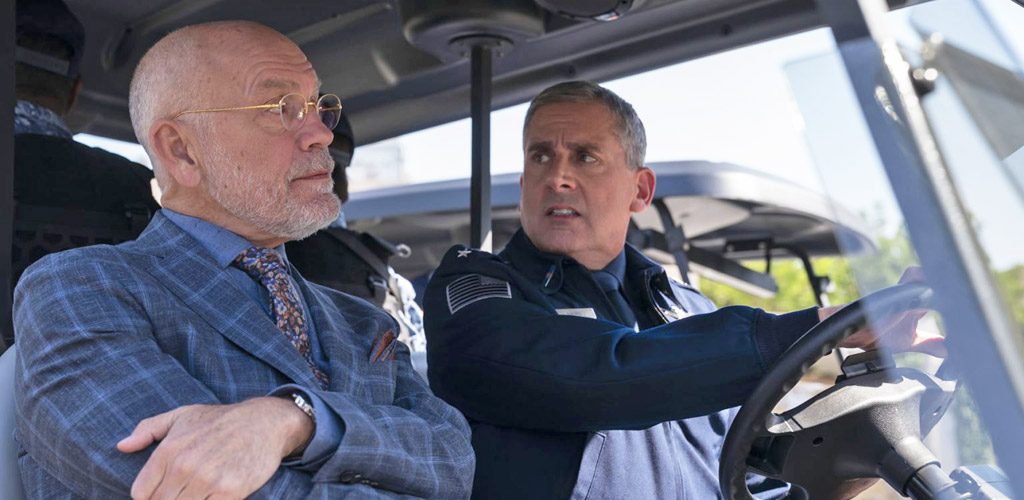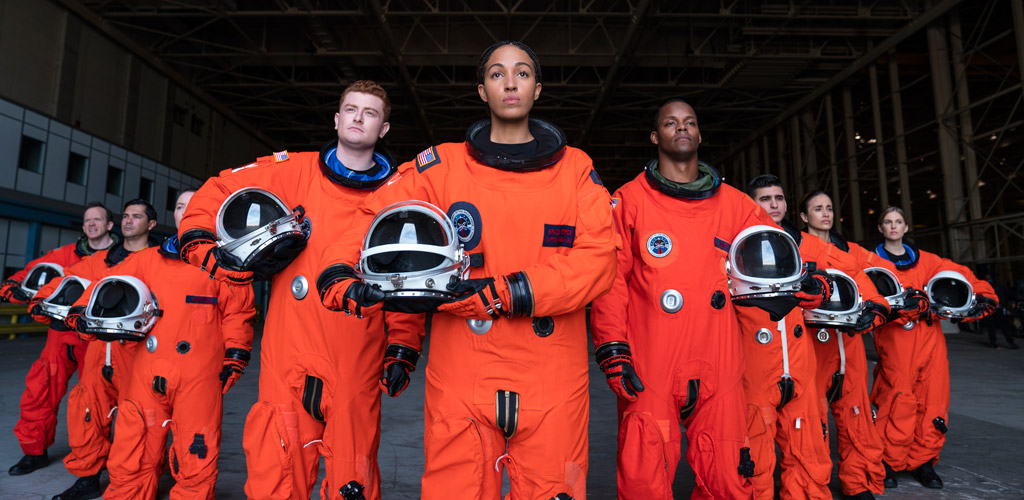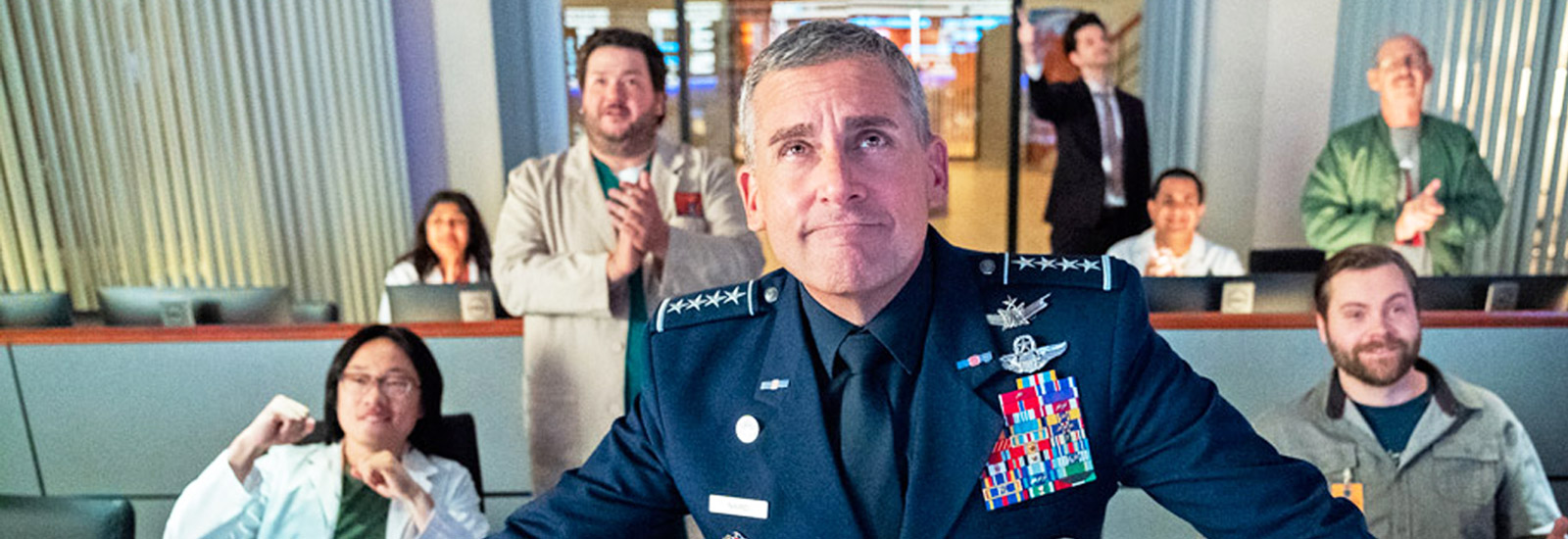As you’re no doubt aware, we’re living in strange times, and I’m not even talking about our current global pandemic situation of which we shall not speak, for at least the next handful of minutes. I’m referring to the so-called United States “Space Force,” which is a thing that (apparently) exists in our reality. I’m still as surprised as anyone else about that development, and it’s not worth rehashing how that sixth branch of the U.S. Armed Forces came to be. Yet the better news is that this real-life “WTF” inspired a launching point for the reteaming of The Office‘s Steve Carell and creator Greg Daniels. The resulting Netflix series, understandably, aims to resurrect the magic while also trying hard to be The Not-Office. The end result is sometimes messy and manic.
On some level, one has to acknowledge that The Office comparisons are inevitable, and it feels like the show was too conscious of this incoming criticism, to its detriment. Carell and Daniels, because of their previous success, are also bound by it until Space Force can prove that it’s shifted into a different gear. Yet given that all nine seasons of The Office are still streaming on Netflix (until later this year), viewers are more than equipped to judge from that high-up standard. Also, yes, we’ve got another workplace comedy from Daniels, who’s now co-creating with Carell, and Ben Schwartz is also onboard to bring the Parks and Recreation vibes. Mostly, though, the show hopes to be a different beast than both previous hits. It’s a tough spot to be in, man, since Space Force (as a Daniels-Carell project) exists because of The Office, but it’s bound to that predecessor even while aiming at different stars.
Look, Space Force is an okay and watchable series, although uneven. If one takes the whole first season (there’s a tee-up for a sophomore turn) into account, the biggest problem is that the show doesn’t immediately reckon with its own identity. At moments, it feels like it’s flirting with the being a bigger-budgeted, higher-concept incarnation of the Office without the mockumentary structure. The show also takes stabs at Dr. Strangelove levels of farcical madness, only without Stanley Kubrick’s masterful helming of characters who belly-flop into sheer stupidity despite certain failure as an outcome. The show also sometimes feels like a twisted family comedy, but Space Force begins to know itself after a handful of episodes, when it starts edging toward an equilibrium.

Carell, of course, is making his return to comedic TV (following Apple TV+’s The Morning Show) to portray the unwitting leader of the U.S. Space Force. Officially, he’s the U.S. Air Force’s highly decorated General Mark R. Naird, who packs up his (also reluctant) family for an incredibly not-scenic, but secret, Colorado base to sign off on billion-dollar missions that spectacularly fail. He’s assisted and opposed by an ensemble cast of recognizable and even iconic presences. John Malkovich (!), Ben Schwartz, Jimmy O. Yang, Tawny Newsome, Lisa Kudrow, Jane Lynch, Patrick Warburton, Noah Emmerich, and Diedrich Bader all pop into and out of the frame at a sometimes dizzying pace. It’s a lot to take in — this cast and this show. As a result, Space Force attempts to be a lot right out of the gate and only starts to succeed when it stops being so “extra.”
A lot of the try-hard feel comes from Carell leaning into Michael Scott mode during scattered, shouty moments that linger past their screentime. Naird’s development feels too arrested until around the midseason point, when he spends an episode in a moon-simulation base. Magically, his struggles then become compelling and watchable and even relatable, and that’s when the show’s writing becomes crisper and other characters more well-rounded. It’s an odd turning point for the show, and a welcome one, since the first episodes of this Netflix series didn’t grab me. Yet it was a relief to see Naird become something other than a (to be blunt) pompous prick who does unfunny things like tasking a monkey with equipment repairs. Once those quirk-stunts stop happening, Space Force becomes a different, better show, although the less-than-smooth introduction may mean that people don’t get that far. Likewise, those who surround Naird start to gain characteristics that move beyond surface level development.
Those players would include the great John Malkovich as Dr. Mallory, the Space Force head scientist and voice of reason; Ben Schwartz as an F-bomb hurling media director whose name and aura suggests The Mooch; and Jimmy O. Yang’s scientist, who’s the closest to being the brains of the operation. Meanwhile, the women of this series are woefully underused for awhile, other than Naird’s daughter, played beautifully by Diana Silvers. It feels like Lisa Kudrow gets the shaft as Naird’s wife, and Tawny Newsome (who plays a Space Force captain that is initially relegated to being Naird’s personal pilot) also isn’t allowed to shine until quite late in the season.

One key strength of Space Force is an unexpected one. Due to the inspiration for its high concept, I expected the show to be much more inherently political than it turns out to be. That’s a relief, although the series doesn’t shy away from an overall critique of governmental ineptitude and appalling, billion-dollar levels of waste. The T-word never surfaces, although it’s plenty clear that the show’s mad-tweeting POTUS (who wants to put “boobs” on the moon, and it might be a typo) is you-know-who. Likewise, the show’s handling of space warfare manages to treat the subject with such absurdity that one would be hard-pressed to find it politically offensive on either side of the coin.
Space Force‘s debut season has a lot going for it, but when one has an incredible cast, an obviously generous budget, and polished production values, those assets can be both a blessing and a curse while a show tries to find its (space) legs. Likewise, the co-creators’ legacies make this a tricky show to evaluate when nostalgia gets involved. When it comes to The Office, affection runs so high (throughout multiple audience generations) that people might forget that its first season wasn’t so wonderful. The show took awhile to catch hold of hearts and minds, and I wonder if Space Force should initially be allowed that same latitude. Is such audience leniency possible in 2020? I’m not sure, though my suspicion is that people will feel very strongly (in a positive or negative sense) about a show that’s more than alright, although not spectacular.
Netflix’s ‘Space Force’ streams on May 29.







